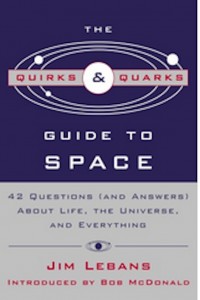 From mad scientists, to lunar landings, to outrageous weapons, science is gracing the big screen. But just what’s plausible, capable, or already happening?
From mad scientists, to lunar landings, to outrageous weapons, science is gracing the big screen. But just what’s plausible, capable, or already happening?
Join one of Canada’s best-known science journalists on November 22nd when the host of CBC’s Quirks & Quarks….http://thevic.ca/item/quirks-and-quarks
For more info about Bob McDonald’s CBC Radio show, visit here: http://www.cbc.ca/quirks/host/. Bob’s Book is entitled:
Measuring the Earth with a Stick: Science as I’ve seen it:
http://www.kidsbooks.ca/The-Quirks-&-Quarks-Guide-to-Space/Product.aspx?ProductID=121009&DeptID=0
http://www.cbc.ca/quirks/books/
 His book, which was short-listed for the Canadian Science Writers Association Book Award, is a collection of essays reflecting on his 25 years as a science journalist. Bob also hosted and wrote a children’s TV science series, Heads Up!, which ran for 3 seasons on TVO and the Knowledge Network. In addition, he is Chairman of the Board for Geospace Planetarium. Here is Bob’s Science Blog: http://www.cbc.ca/quirks/host/
His book, which was short-listed for the Canadian Science Writers Association Book Award, is a collection of essays reflecting on his 25 years as a science journalist. Bob also hosted and wrote a children’s TV science series, Heads Up!, which ran for 3 seasons on TVO and the Knowledge Network. In addition, he is Chairman of the Board for Geospace Planetarium. Here is Bob’s Science Blog: http://www.cbc.ca/quirks/host/
For info on Our Awesome Science Learning Lesson Plans, Games and Activities, feel free to visit here:
http://www.science-lessons.ca/lesson-plans/index.html
http://www.science-lessons.ca/games/brain.html
]]>
1. Which Galaxy do we live in on Earth?
2. Is our Sun considered to be a Star or a Planet?
A Star
3. When did a human being first set foot on the Moon?
1969
4. What planet is known for being Red even though its faux tv fiction inhabitants are considered to be Green?
Mars
5. What planet has the hottest temperatures of 500 degrees Celsius? Is it red Mars?
Venus
6. What is the name of Nasa’s most popular telescope?
The Hubble
7. How old is our Solar System?
4.6 billion years old
8. How long does it take for Light from the Sun to reach our Earth?
8 minutes
9. A Solar Eclipse occurs when the “what” is between the Sun and the Earth?
The Moon
10. Comets are made of dust particles, rock particles and what?
Ice
11. The hazey glow and tail around Haley’s Comet are known as a what?
A Coma
12. The surface of Venus rages with active what?
Volcanoes
13. Scientists estimate that the extinction of dinosaurs on planet Earth was caused by what?
An Asteroid
14. How many planets does our Solar System have?
8
15. What in our Solar System used to be, but is no longer, considered to be a planet by Nasa?
Pluto
16. Who was the first human being first set foot on the Moon?
Neil Armstrong
17. The Earth’s ocean tides are caused largely by the Moon’s pull of what?
Gravity
18. What races around Saturn at a rate of 800 km per hour?
Wind; Storm Wind
19. If you were on Jupiter, you would weight 2 and half times the weight than when you are on Earth because of the what?
Magnetic Field
20. What planet has the worst stormy weather of all the planets?
Neptune
Then try one of our Fun Games for Learning more about the Solar System:
]]>An extrasolar planet, or exoplanet, is a planet outside the Solar System. Extrasolar planets became an object of scientific inquiry in the nineteenth century. Many astronomers supposed that they existed, but there was no way of knowing how common they were or how similar they might be to the planets of our solar system. The first confirmed detection was made in 1992, arising interest in the possibility of extraterrestrial life. Most of the discovered extrasolar planets lie within 300 light years of the Solar System. Regardless of the precise number of stars with planets, the total number of exoplanets must be very large. Since our own Milky Way Galaxy has at least 200 billion stars, it must also contain billions of planets – if not hundreds of billions.
Precise measurements using the Kepler space telescope have shown that the planet, named Kepler 10b, has a diameter 1.4 times that of Earth, and a mass 4.6 times higher. Measurements of Kepler techniques using astero-seismology showed that the parent star was about eight billion years old – a grandparent among stars of its type. Kepler techniques are similar to the study of earthquakes on the Earth. In addition to the size of the host star, the details of the planet’s and star’s “dance” with each other, and the planet’s radius, the density of the planet can be calculated. Geoffrey Marcy University of California Berkeley marked this as “among the most profound scientific discoveries in human history.”
Since January 11 of this year (2011), astronomers announced confirmation of 518 such planets – with hundreds others awaiting for confirmation pending further investigation. Most are giant planets thought to resemble Jupiter.
http://www.bbc.co.uk/news/science-environment-12158028
Kepler Mission
The Kepler Mission is a NASA space observatory designed to discover Earth-like planets orbiting other stars. It was launched on 7 May 2009. The mission spacecraft is named in honor of 17th C astronomer Johannes Kepler.
http://www.kepler.nasa.gov/news/nasakeplernews/index.cfm?FuseAction=ShowNews&NewsID=94
Most exoplanets cannot be seen directly through telescopes because bright light from the stars that they orbit drowns them out. Instead, astronomers use a variety of indirect techniques to find them. One method is to look for tiny wobbles in stars’ positions caused by their gravitational interactions with orbiting planets.
Johannes Kepler (1571 – 1630) was a key mathematician, astronomer and astrologer, in 17th century scientific revolution. He is best known for his laws of planetary motion, later developed by later astronomers. Kepler lived in an era when there was no clear distinction between astronomy and astrology, but there was a strong division between astronomy (a branch of mathematics within the liberal arts) and physics (a branch of natural philosophy).
Kepler also weaved religious reasoning into his work, motivated by the religious conviction that God had created the world according to an “intelligible plan that is accessible through the natural light of reason.” Kepler described his new astronomy as “celestial physics”. (Ref: Wikipedia: Johannes Kepler; Exoplanet, Exosolar)
For one of our Fun Learning games on the Solar System and Teaching Space:
]]>The first part of this science lesson is making a solar system using candies for planets. It doesn’t show you the true size difference but it does bring out some of the main characteristics. The second part is about the fantasy of living somewhere within it!
Part 1: Creating The Solar System
You can either draw your orbits on black construction paper, or a paper plate.
Sun – Butterscotch
Mercury – Orange Jujube
Venus – Nestle’s Sno Caps;
Earth – Blue Skittle;
Mars – Red Skittle;
Asteroid Belt – Candy Sprinkles;
Jupiter – Peppermint with Red Hot stuck on top;
Saturn – Lemon Drop with Twizzler wrapped around;
Uranus – Green Jujube;
Neptune – Aqua Skittle;
Pluto – Tart ‘n’ Tiny;
Sweet Tarts and Mini-M&Ms are also possibilities. Be creative!
You can also give each student a planet and let them guess how far they would be from the sun. Start by giving where Pluto is so they have an idea of the area; then have them measure the correct amount.
Using the web link called Exploratorium is a fun converter that can make your solar system any size:
http://www.exploratorium.edu/ronh/solar_system/index.html
Part 2: Planet Postcard
Students choose their planet of preference to be from, pretend they live there, and they write to a friend describing their planet. Some specs to write about could be the temperature, humidity index, colors of the terrain, craters, life forms. Then instruct them to make a planet tourism advertisement where persuade people to come to their planet and visit!
Here is one of our fun games about the Solar System:
http://www.science-lessons.ca/games/space.html
]]>Because of its rarity, it has been cut and divided to be shared amongst museums and researchers around the world. It is now helping researchers find out more about the universe in a different time/space, the formation of minerals inside asteroids, and minerals that may match to its makeup inside the Earth.
Meteorites have been found on the Moon, on Mars, and in places where they have landed on Earth, and generally range in size from marbles to basketballs, though some are very large. A meteorite is made by nature, originating from outer space, before it falls to and collides with the Earth’s surface, sometimes leaving a crater. As it travels through space, atmospheric pressure causes it to heat up until it forms a fireball emitting light sparks. In this state, it is often referred to as a shooting or falling star that if you see with the naked eye from Earth when looking up into the sky, you can make a wish upon it during its flight. Falling meteorites have reported to cause damage to people, livestock and land, so better to wish upon it fast, and then step out of the way!
For more information on meteorites and the pallasite chunk being researched this week at the Royal Ontario Museum, you can visit these websites:
http://www.cbc.ca/technology/story/2010/07/21/rom-meteorite-pallasite-saskatchewan.html
For short video:
http://www.cbc.ca/video/player.html?category=News&zone=technology&site=cbc.technology.ca&clipid=1549385557
And for a fun learning game for the solar system, you can go here:
http://www.science-lessons.ca/games/space.html
]]>Read the original post:
Teaching Space and the Solar System | New Space Exploration
Original post:
Teaching Space and the Solar System
Space Quiz Master Game (Grades 6 – 8)
Here is the original:
]]>Read the original post:
Ideas for Teaching Space and the Solar System
Solar system may be interesting for some students but it can also be a boring subject for the others. It is the problems of every teacher who wants to teach solar system. To make the students get the enthusiasm in the space and solar …
More on a similar topic:-
Does anyone believe Schools will start teaching the solar system to have only 8 planets rather than 9 or not?
I will be doing that with my classes starting this semester. Pluto is a very small and distant body about which we know very little any way. It is the only “planet” that has not yet been visited by a probe. (There is one on its way out